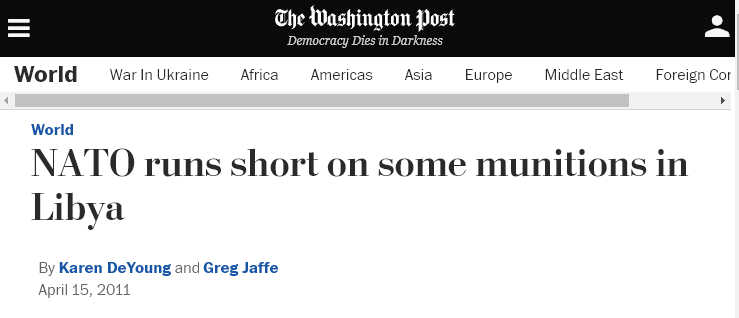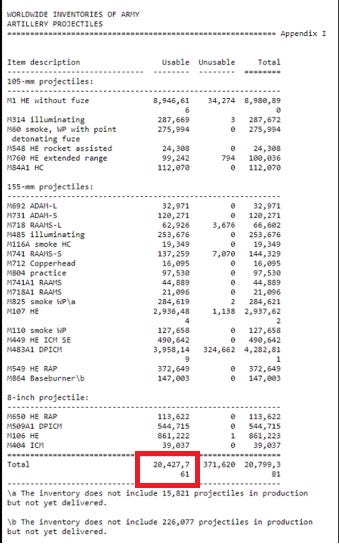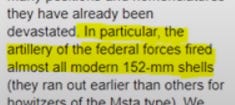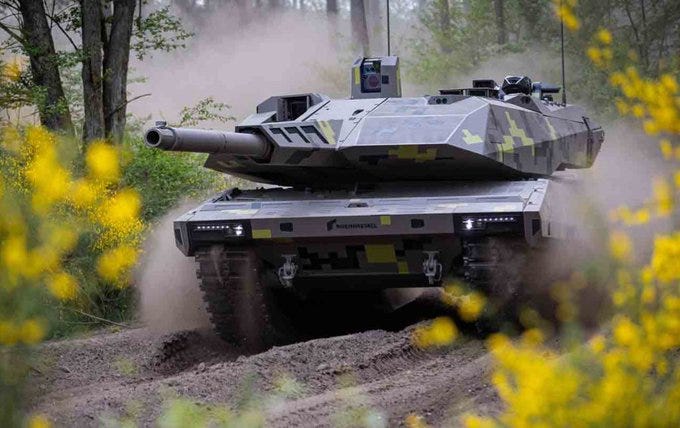On Shells And Armor: The War Of Sustainment
Brief by-the-numbers exploration of the production war between NATO/Ukraine and Russia.
Shells, Shells, And More Shells
Let’s discuss the prospects of sustainment for both sides, Nato/Ukraine vs. Russia.
We know that Ukraine uses a purported 5,000-6,000 shells per day, and that Russia has been estimated to fire as many as 60,000—though that’s a high ‘peak’ amount—the daily average over the course of the war being closer to ~20,000-30,000.
The U.S., self-avowed manufacturing ‘powerhouse’ of the world, produces 14,000 shells a month and have recently announced a “3X production surge” to 40,000 to help Ukraine—which was soon after desperately amended to 90,000 to staunch AFU’s rapidly accumulating losses. Even for the U.S., it’s an effort large enough to take approximately 2-3 years to ramp up to.
One explanation is that arms companies are reluctant to commit the necessary, pricey equipment and personnel investments to vastly ramp production when they suspect the war might soon end anyway, resulting in the loss of investment in all those new equipment/personnel-training costs they’ve incurred. Those costs are only worth it if long term profits are guaranteed, and the way it’s looking for the AFU, guarantees are iffy.
The NYTimes just released a report on U.S.’s 155mm shell manufacturing facilities and capabilities—a decidedly archaic looking process; some of the machines, they admit, are on the wrong side of 80 years old and were not designed for such modern escalation. The U.S. had over 80 such factories during the cold war, now only 5 survive—and really it’s just one general process line: the manufacture is spread out over 5 different facilities, each contributing a different component; raw steel for the shells in a ‘steel country’ Pennsylvania plant, the explosives manufactured elsewhere in Tennessee, and final ‘assembly’ in an Iowa plant.
This thread outlines Canada’s capabilities. At best they can produce 12k shells a month with a dedicated surge, but realistically a mere 6k.
England’s woes go as follows:
In England, the situation is the most sad. The government is trying to reach an agreement with BAE Systems to expand shell production, but the word is absolutely penniless, especially given the cuts in the military budget under Sunak. They don't have enough ammunition or money even for their meager army, such as Ukraine.
Germany fares little better. A Reuters article reports that Rheinmetall can surge their production to 400-500k 155mm shells per year, which amounts to 33-42k per month. But Germany and NATO allies are planning to build new factories in both Poland and Hungary for 155mm shells, as well as un-mothball one in Romania—but all these ramp ups will take time.
Additionally, Ukraine consumes both Soviet standard 152mm and NATO 155mm. The ratio’s unknown but for argument’s sake we can assume 50/50, give or take. Although in reality, Ukraine had far more Soviet-era artillery systems which shoot 152mm, than new NATO-supplied 155mm systems.
The problem is, most of these ramp-ups are for NATO 155mm only, since most NATO countries don’t produce 152mm. But 155mm howitzers are exactly what Ukraine will likely run out of first, as Western equipment is far scarcer in general, and breaks down faster. So they’ll suffer from a particularly bad 152mm shell famine.
Outside of a couple factories in small ex-Soviet/Soviet-affiliated countries like Bulgaria, Romania, and Czech republic, the West doesn’t have any capability to supply 152mm. And those likely can’t produce anywhere near enough to sate Ukraine’s gluttonous appetites. Particularly because Russia appears to have long engaged in sabotaging most remaining European 152mm production lines, as an unlikely spate of ‘coincidental explosions’ took down a Czech arms factory in 2014, a Bulgarian arms factory more recently, as well as Romanian arms plant right before the start of the SMO.
Add them all together: the full ramped up rate of 90k a month for U.S., 6k for Canada, ~40k for Germany (the highest in Europe, as they stated), and let’s be generous and say an additional 50k a month from various other countries to supplement (France, Australia, etc), we get a total of 186,000 per month x 12 = 2.2 million a year.
186k per month is exactly 6,200 a day, which precisely matches AFU’s expenditures. So, one can see that at full ramp up, NATO should theoretically be able to just eke out keeping Ukraine afloat.
One interesting point though is that this would mean NATO at max capacity would just be breaking even in shell production for Ukraine alone. Suppose NATO itself was drawn into hostilities with Russia, or even China, then what? They would not be able to supply both Ukraine and themselves.
This has been repeatedly highlighted recently by Western press, in articles like this one. And this:
The report from the Center for Strategic & Int’l Studies from the first link states that:
The U.S. defense industrial base is not adequately prepared for the international security environment that now exists. In a major regional conflict—such as a war with China in the Taiwan Strait—…the United States would likely run out of some munitions—such as long-range, precision-guided munitions—in less than one week.
Likewise, short memories have tucked away NATO’s own sustainment issues during their far less intense forays, in recent years. This Washington Post article from 2011, writes:
Less than a month into the Libyan conflict, NATO is running short of precision bombs, highlighting the limitations of Britain, France and other European countries in sustaining even a relatively small military action over an extended period of time, according to senior NATO and U.S. officials.
Sound familiar? Echoes of the West’s own endless squalls of accusations towards Russia’s perceived ‘arms drought’ during the SMO. On the contrary, Russia seems to be doing fine with missiles and armaments; but NATO, punching down at a ‘nowhere-near-peer’ opponent, in a low intensity fight, could hardly adequately sustain themselves.
But getting back to shells, the big million dollar question on which this entire war hinges: is Russia any better off? The truth here is murkier.
On one hand, Soviet 152mm shell stocks were said to be expectedly enormous. Russia inherited much of the Soviet/Warsaw Pact stock of these munitions and some estimates place it as high as 150 million shells, others a more temperate 30-50 million.
To give credence to these numbers, we have official printouts of the U.S. Armed Forces total global shell stockpiles of 1995. Not counting the Marines, the U.S. had over 20+ million 105mm, 155mm, and 8inch shells. And keep in mind, the U.S. is famously not an artillery force, and has a tiny fraction of Russia’s doctrinal artillery utilization.
Ergo, we can confidently assume Russia’s Soviet-inherited stock would be orders of magnitude greater than this, given that they were doctrinally an artillery heavy force. Stocks of minimum 3X of the U.S. are believable, and even 10X would not strain credulity.
But, that’s not taking into account a ten year long Afghan war, during a steadily declining economic landscape under Gorbachev’s administration, followed by roughly another decade of two back to back Chechen wars, at a time when, in the 90’s, the Russian defense industry was likely only puttering along in production. So it may come as no surprise that reports, such as this one from a July 2002 Russian article, pointed to 152mm shell depletion by the latter half of the Second Chechen War.
If that’s even remotely plausible, then there’s little chance Russia would’ve restored their stockpiles to anything resembling Soviet days between then and now. Although note the distinction: “all modern 152mm”. Older Soviet stock has a separate ‘refurbishment’ production line—these are shells whose fuses or warheads may have expired and/or needed updating. So this could mean they still had old stocks left, which were in the process of refurbishment, but concurrently produced new stock was being run dry straight off the assembly line.
One report claims that Estonian intelligence found Russian 152mm shell stockpiles on the eve of the SMO were in the region of 17 million, and that Russia can produce 3.4 million per year. This is fairly credible and realistic.
Accepting that Russia mostly depleted usable 152mm stocks by the early 2000’s (not counting aging stocks requiring refurbishment), it’s credible that Russia spent the next two decades producing at a moderate rate equivalent to the U.S.’s 90k a month, which would grant them about 1 million shells per year. And twenty years of such stockpiling, from the early 2000’s, would give approximately 20 million—in line with Estonian estimates.
Russia used an estimated 7-10m so far in the first year of the SMO (20-30k per day multiplied by roughly a year). If the Estonian estimates are accurate that means Russia could have ~7-10m left, which is about another year’s worth of shells.
In WW2, the USSR was said to have produced 100 million shells per year, just to give an idea of what’s possible. Also, as a rule, Russia has several times more arms factories compared to the U.S. per category. For instance, the famed Lima plant in Ohio produces all American Abrams. Russia’s top tank producer Uralvagonzavod alone has roughly 12 factories, though they’re not all committed to tank production. Some produce civilian equipment like train cars, others full-time tank modernization/refurbishments, like upgrading the older T-72’s to T-72B3 standard.
So if U.S. can do 90k shells a month (1m/year) on only one production line by merely increasing shifts, Russia likely has several such production lines, in the famed Tula Arms plant and elsewhere, and should be able to comfortably triple that, at the minimum. And tripling 1m shells gets us to exactly what Estonian intel reportedly estimated Russia manufactures per year; or this source which claimed Russia was assembling 2 million shells per annum comfortably:
We can assume a serious ramp up could credibly allow the production of 7 million plus, covering the SMO’s expenditures.
However, there’ve been indications or “reports” since about December that Russia is already experiencing a shell hunger. And not just Ukrainian ‘propaganda’ sources, but also reputable Russian ones, like Vladlen Tatarsky of the DPR, although admittedly some of those perspectives are limited. Also, some of the rumors sprang from the purported Russian draw down from firing 60k+ a day to 20-30k several months ago. But other valid explanations for why Russia would have slowed down around that time exist, as a large operational reorganization (as well as mass mobilization) was being conducted at the time, effectively ‘pausing’ most major offensive operations in preparation for the next, large coming phase.
The reports, though, were backed by photo evidence of serial numbers found on some Russian 152mm shells tied to recent production lines. But that doesn’t necessarily mean Russia has depleted their stocks—they could just be mixing and matching; but it’s food for thought.
Also, reports that North Korea has begun supplying 152mm stock to Russia, based on satellite photos of trains the U.S. obtained. If true, it could simply signal Russia’s logistically wise decision to supplement their own production. After all, why not gorge on extra procurement when you have an extremely able, willing, reliable, and convenient (close location) source right on your border who can supplement and ease the burden?
Besides, Russia could just be shrewdly preparing for the future, building up inventory in case of a potential wider war with NATO, to cover its bases. There are many reasonable explanations that don’t necessarily point to stock depletion—but it’s something to consider all the same.
Either way, neither side will ever completely run out of shells, as there is clearly demonstrated capacity for both to keep producing. The only question is can Russia produce enough to sustain an extremely high-intensity advancing operation, which requires ramping daily expenditures to highs beyond the 20-30k of the medium-intensity positional warfare that’s characterized the last few months.
A last clue came from the announcement that Russia has increased production of Krasnopol laser-guided shells “several times over”. If we assume ‘several’ to be at least 3 if not more, then we can infer that all shell production has likewise increased, particularly as 3X neatly corresponds to a max tripling of shifts at a given arms plant.
Tanks & Armor
And briefly on tanks and armor: through much of the 2000’s Russia’s Uralvagonzavod has demonstrably been capable of producing around 200-250 new tanks per year, and upgrading 600-650 tanks to modern standards, which typically includes turning T-72B’s into T-73B3’s, T-80’s and T-80U’s into T-80BVM’s, and T-90’s into T-90M’s, etc.
The above obtained chart shows production numbers of tanks per year for the 2007-2014 period. The rows on the left are: Russia, USA, Germany, China, and Poland. It can be seen Russia produced 148 in 2007, 77 in ‘08, 130 in ‘09, 248 in ‘10, 338 in ‘11, etc. The total for the period is 1,291 tanks.
This is more than the other countries produced, combined. And this is not counting the upgrades/modernizations, not to mention these are slow interwar periods with no need for urgency or production ramp-ups. In short, that is Russia’s ‘comfortable’ and sustainable production pace.
In 2022 however, Shoigu reportedly ordered Uralvagonzavod to more than double the production output to 480 new tanks per year, and also ordered the construction of two new factories specifically for upgrading and repairing armor, which would increase the modernization capacity exponentially. Although, there is no currently known timetable for those factories or how fast they intended to put them up.
Fact is, Russia can credibly manufacture a minimum of 250 up to a goal of 480 new tanks per year, and upgrade an additional 600+. That means each year, Russia can deliver somewhere in the range of 800-1,100 fresh tanks to frontline service. Keep in mind, at its peak, employing over 4,000+ people, the American Lima plant was producing 120 M1A1 Abrams per month, or 1,440 a year, and Russia was said to produce upwards of 1,200 to 1,600 tanks per year in the Soviet 80’s. So these numbers are not otherworldly, and likely do not even represent Russia’s full ramp-up capabilities. If they continue expanding and ramping, within 2-3 years they could likely match those numbers and more.
The infamously inflated (and nigh fraudulent) ‘Oryx’ list claims that Russia has so far lost upwards of 1,500+ total tanks. This combines both ‘destroyed’ and ‘captured’. However, accepting it for the moment, what most people miss is this list does not discriminate between DPR/LPR and Russia. It represents total ‘Allied’ armor lost.
There are reasons to believe the LDPR forces lost much more armor than Russia, given that in many of the most intense fights (Mariupol, Severodonetsk, etc), proper Russian forces played a more auxiliary role, providing the rear-end artillery firepower or smaller elite infiltration or support groups, while the bulk of the grinding armor and shock forces belonged to the LDPR. And not to mention that LDPR’s tanks obviously use the same ubiquitous tactical symbols and designations, Z’s, etc., which makes discriminating in photos impossible, barring the circumstance when a tank is of an obvious model type that Russia itself doesn’t normally use (i.e. T-64, etc).
But indulging the inflated list for argument’s sake, we’ll estimate that only half of it is actual Russian armor, the remainder being that of LDPR—so about 750+ lost Russian tanks. That means in a single year, Russia would have already replaced their full armor losses via the proven 800-1100+ tank production numbers outlined above. And given the fact that the Oryx list is greatly inflated (by way of multiple proven audits, and for a variety of reasons like double and triple counting, endless mis-attributions—both deceptively intentional and not—outright fakes (many ‘photoshopped’ tanks were spotted with Ukrainian crews crudely removed to make it look like an ‘abandoned’ Russian tank)), we can assume that maybe only 400-500 (or even less) of those losses are actual Russian tanks rather than LDPR. That means Russia could have by now more than doubled those losses in new procurements. And the spate of recent videos bear testament to that, as we’ve witnessed a slew of the newest and latest Russian armor, upgraded and otherwise, flooding the lines—many new T-90M’s in particular, T-80BVM’s, etc.
So the belief that Russia is ‘running out of armor’ couldn’t be further from the truth. Russia’s proven peacetime procurements (850 total per year via 250 new, 600 upgrades) were already enough to make up for the likely total losses in Ukraine. The new expanded and ramped production has already surpassed the losses and is now generating a net gain in armor.
Ukraine on the other hand is in bad shape. If official Russian figures are even remotely accurate, Ukraine has lost the vast bulk of its pre-war MBT’s. The new infusions from the West, which look something like this:
Are an impressive 441 total pledged—though don’t be fooled, much of that is either dubious, or on an extended ‘delivery timeline’, i.e. a year or two. And given that Ukraine has lost an estimated 1200-1500 total MBT’s or more by Russian estimates, the piecemeal replenishment can only make up a fraction of it—whereas Russia, as outlined, has likely fully replenished its losses and is now adding a net gain of armor.
Recent comical announcements seem more ‘performative’ in their gestures of generosity. To wit, today’s announcement by Germany’s Rheinmetall to supply their new-age, still ‘conceptual’ Panther tanks is downright mean-spirited in its carrot-n-stick cynicism turned media ploy, designed for what purpose?—even I can’t fathom.
After all, as I outlined in this recent article, even the aging Challenger-2 is set to be coddled like a porcelain Fabergé egg, imagine the lengths to which they’d go to keep a futuristic Kf51 Panther safe from Comrade Kornet and friends.














Worked with a Russian fellow. Been a couple years since, but he talked about there are many small mom and pop tank and armor, weapons and ammo shops, the Russian procurement system contracts work to. Such as small outfits who install upgrade kits on late T65, T70s and R80s, ot they will do a bunch pf final fit up, or install reactive armor kits, lot of shops employ ladies and babooshkas who do the intricate painstaking and detailing things, he said similar with ammo and small arms components. Makes common sense, used to be similar in the US, I grew up and worked 47 years as a welder, a lot of it in aerospace and .mil contract shops, when we used to manufacture things in this country, small shops are what makes big production possible, its similar in the automotive and truck industry till the tarrif/offshore wealth transfer treaty rackets started.
But whats really critical and you almost never hear of it because being a makere and a craftsman in skilled trade has been so long looked down on now since the 70's, os institutional knowledge of the skilled labor trades, you lose that it requires decades to recreate it. Probably more time now because so many have forgotten what an axe, a shovel, and a Rifle are for, to coin a phrase. Besides the corporate vulturism and class structure begin in the 80's, if you did not go to colledge you where dirt, and they did everything to diminish the labor value of skilled labor, and it was nothing to do with any union stuff, this was flat out comdpiracy across corporate America to set the cheapest pay rates they would all stick with in order to create rea;;y low wages because no longer was there any compotition for say a skilled welder like me, every ridgid tube assembly house, be it GE's engine shop in Hookset NH or PanAm's at JFK, they all paid the same wage, same if you would go to a general metal fab job shop, same with tool and die guys, or precision sheetmetal fabricators, after awhile no one wanted a career in these trades, they paid just above survival wages.
So there is that and believe you me, it matters more than a lot of things, you dont have a skilled workforce you dont make much of anything.
My last welding gig was in a premier rocket and jet engine tube assembly shop, to do weldments they have to have certified fusion welders, i was the only old hand there, lot of years there, one day the big cheese comes asks me how can the company get any skilled welders, nobody shows up to job fares or answers adds. Told him outright, the pay sucks for welders, nobody wants to be one because of it, few weeks later I get a $10 dollar hour raise unasked, shows up in my paycheck, and they ask me to become a weld teacher for the company, train green employees how to weld, but other than a couple old guys like me, they still could not get new welders with a pretty decent payrate increase. They just could not get it. Skilled labor, true cradt labor, its a culture thing and a tradition thing and it was destroyed by globo=peedo to squeeze the last buck out of America, i watched it happen.
That was trhe conversation with this Russian fellow, we where talking about the various reades in each of our countries, and it was clear to me Russia never lost that institutional/time honored traditions in trades and skills and makers crafts, all those people are no more there is no legacy here in the US, but we sure did have it in my lifetime in America, just like Russia still has. The west is Kaput, I could see it in the early 90's coming, for the reasons above. And all the implications.
Russia can never be defeated now, not because of manufacturing might but because of spirit, because its a nation made up of men and woman who not only know what an axe a shovel and a Rifle is for, they are good folks who appreciate what those things are for and more so those who know how to use them. The manufacturing might and capacity follows.
Those ladies putting upgrade kits on tanks and BMPs, they put Love into them, O'm not shitting about it, its love because people like that when they put their labor into it, they do so because, it ain't gonna fail because of me, mentality and mindset.
Its something the satanists despise as nothing else and destroying that in a productive prosperous happy nation is the prime directive. All that you ain't shit unless you go tocalledge was class and culture warfare/pogrom. To wreck what was gear about America.
And you can't turn it back on like lights in a new factory no matter what you do or throw money at. That stuff came with the founding of America. It built this country. It is men in suits who destroyed it after men in a pair of dungarees and wotk boots created it, (woman included too absolutely).
Very well written article simp
You have a talent for this